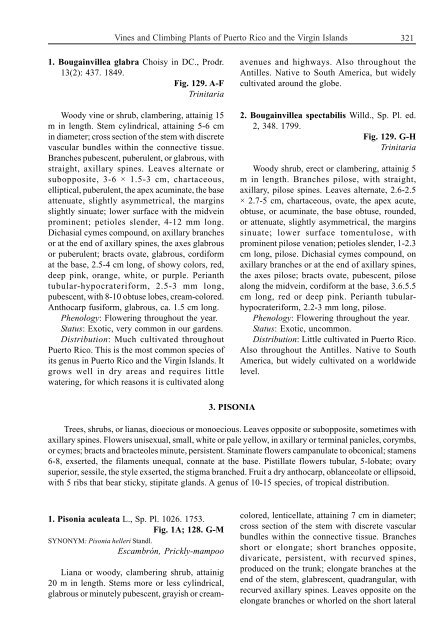Vines and Climbing Plants of Puerto Rico and the Virgin Islands
Vines and Climbing Plants of Puerto Rico and the Virgin Islands
Vines and Climbing Plants of Puerto Rico and the Virgin Islands
Create successful ePaper yourself
Turn your PDF publications into a flip-book with our unique Google optimized e-Paper software.
<strong>Vines</strong> <strong>and</strong> <strong>Climbing</strong> <strong>Plants</strong> <strong>of</strong> <strong>Puerto</strong> <strong>Rico</strong> <strong>and</strong> <strong>the</strong> <strong>Virgin</strong> Isl<strong>and</strong>s 321<br />
1. Bougainvillea glabra Choisy in DC., Prodr.<br />
13(2): 437. 1849.<br />
Fig. 129. A-F<br />
Trinitaria<br />
Woody vine or shrub, clambering, attainig 15<br />
m in length. Stem cylindrical, attaining 5-6 cm<br />
in diameter; cross section <strong>of</strong> <strong>the</strong> stem with discrete<br />
vascular bundles within <strong>the</strong> connective tissue.<br />
Branches pubescent, puberulent, or glabrous, with<br />
straight, axillary spines. Leaves alternate or<br />
subopposite, 3-6 × 1.5-3 cm, chartaceous,<br />
elliptical, puberulent, <strong>the</strong> apex acuminate, <strong>the</strong> base<br />
attenuate, slightly asymmetrical, <strong>the</strong> margins<br />
slightly sinuate; lower surface with <strong>the</strong> midvein<br />
prominent; petioles slender, 4-12 mm long.<br />
Dichasial cymes compound, on axillary branches<br />
or at <strong>the</strong> end <strong>of</strong> axillary spines, <strong>the</strong> axes glabrous<br />
or puberulent; bracts ovate, glabrous, cordiform<br />
at <strong>the</strong> base, 2.5-4 cm long, <strong>of</strong> showy colors, red,<br />
deep pink, orange, white, or purple. Perianth<br />
tubular-hypocrateriform, 2.5-3 mm long,<br />
pubescent, with 8-10 obtuse lobes, cream-colored.<br />
Anthocarp fusiform, glabrous, ca. 1.5 cm long.<br />
Phenology: Flowering throughout <strong>the</strong> year.<br />
Status: Exotic, very common in our gardens.<br />
Distribution: Much cultivated throughout<br />
<strong>Puerto</strong> <strong>Rico</strong>. This is <strong>the</strong> most common species <strong>of</strong><br />
its genus in <strong>Puerto</strong> <strong>Rico</strong> <strong>and</strong> <strong>the</strong> <strong>Virgin</strong> Isl<strong>and</strong>s. It<br />
grows well in dry areas <strong>and</strong> requires little<br />
watering, for which reasons it is cultivated along<br />
3. PISONIA<br />
avenues <strong>and</strong> highways. Also throughout <strong>the</strong><br />
Antilles. Native to South America, but widely<br />
cultivated around <strong>the</strong> globe.<br />
2. Bougainvillea spectabilis Willd., Sp. Pl. ed.<br />
2, 348. 1799.<br />
Fig. 129. G-H<br />
Trinitaria<br />
Woody shrub, erect or clambering, attainig 5<br />
m in length. Branches pilose, with straight,<br />
axillary, pilose spines. Leaves alternate, 2.6-2.5<br />
× 2.7-5 cm, chartaceous, ovate, <strong>the</strong> apex acute,<br />
obtuse, or acuminate, <strong>the</strong> base obtuse, rounded,<br />
or attenuate, slightly asymmetrical, <strong>the</strong> margins<br />
sinuate; lower surface tomentulose, with<br />
prominent pilose venation; petioles slender, 1-2.3<br />
cm long, pilose. Dichasial cymes compound, on<br />
axillary branches or at <strong>the</strong> end <strong>of</strong> axillary spines,<br />
<strong>the</strong> axes pilose; bracts ovate, pubescent, pilose<br />
along <strong>the</strong> midvein, cordiform at <strong>the</strong> base, 3.6.5.5<br />
cm long, red or deep pink. Perianth tubularhypocrateriform,<br />
2.2-3 mm long, pilose.<br />
Phenology: Flowering throughout <strong>the</strong> year.<br />
Status: Exotic, uncommon.<br />
Distribution: Little cultivated in <strong>Puerto</strong> <strong>Rico</strong>.<br />
Also throughout <strong>the</strong> Antilles. Native to South<br />
America, but widely cultivated on a worldwide<br />
level.<br />
Trees, shrubs, or lianas, dioecious or monoecious. Leaves opposite or subopposite, sometimes with<br />
axillary spines. Flowers unisexual, small, white or pale yellow, in axillary or terminal panicles, corymbs,<br />
or cymes; bracts <strong>and</strong> bracteoles minute, persistent. Staminate flowers campanulate to obconical; stamens<br />
6-8, exserted, <strong>the</strong> filaments unequal, connate at <strong>the</strong> base. Pistillate flowers tubular, 5-lobate; ovary<br />
superior, sessile, <strong>the</strong> style exserted, <strong>the</strong> stigma branched. Fruit a dry anthocarp, oblanceolate or ellipsoid,<br />
with 5 ribs that bear sticky, stipitate gl<strong>and</strong>s. A genus <strong>of</strong> 10-15 species, <strong>of</strong> tropical distribution.<br />
1. Pisonia aculeata L., Sp. Pl. 1026. 1753.<br />
Fig. 1A; 128. G-M<br />
SYNONYM: Pisonia helleri St<strong>and</strong>l.<br />
Escambrón, Prickly-mampoo<br />
Liana or woody, clambering shrub, attainig<br />
20 m in length. Stems more or less cylindrical,<br />
glabrous or minutely pubescent, grayish or cream-<br />
colored, lenticellate, attaining 7 cm in diameter;<br />
cross section <strong>of</strong> <strong>the</strong> stem with discrete vascular<br />
bundles within <strong>the</strong> connective tissue. Branches<br />
short or elongate; short branches opposite,<br />
divaricate, persistent, with recurved spines,<br />
produced on <strong>the</strong> trunk; elongate branches at <strong>the</strong><br />
end <strong>of</strong> <strong>the</strong> stem, glabrescent, quadrangular, with<br />
recurved axillary spines. Leaves opposite on <strong>the</strong><br />
elongate branches or whorled on <strong>the</strong> short lateral
















